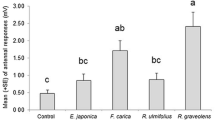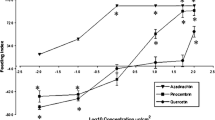Abstract
Bioassays using bean leaf discs were conducted to investigate toxic and behaviour-modifying effects of carvacrol and thymol, two monoterpenoid phenols, on second instar larvae of Frankliniella occidentalis (Thysanoptera: Thripidae) at concentrations of 0.1% and 1%. We tested the contact toxicity of carvacrol and thymol to F. occidentalis larvae and studied the settlement preference of thrips larvae for treated or untreated bean leaf discs and the effects of the compounds on their feeding activity. Mortality rates after 24 h were 24.1% for carvacrol at 1% concentration, 16.5% for carvacrol at 0.1%, 7.7% for thymol at 1% concentration and 3.6% for thymol at 0.1%. Thrips larvae showed a significant preference for untreated leaf discs in choice tests with carvacrol 1% or thymol 1%. Likewise, in the no-choice tests feeding damage after 24 h was significantly lower on leaf discs treated with 1% carvacrol or 1% thymol compared to the control, but not on discs treated with 0.1% concentration of either compound. We conclude that an application of carvacrol or thymol to bean leaves does not result in a high mortality of F. occidentalis larvae but affects their behaviour.
Similar content being viewed by others
References
Abbott WS, 1925. A method of computing the effectiveness of an insecticide. J Econ Entomol 18, 265–267.
Buckingham J, 1994. Dictionary of natural products, Vol 3. Chapman & Hall, London.
Chiasson H, Vincent C & Bostanian NJ, 2004. Insecticidal properties of a Chenopodium-based botanical. J Econ Entomol 97, 1378–1383.
Childers CC, 1997. Feeding and oviposition injuries to plants. In: Lewis T (ed.): Thrips as crop pests, pp. 505–537. CAB International, Oxon, United Kingdom.
Cook SM, Khan ZR & Pickett JA, 2007. The use of push-pull strategies in integrated pest management. Ann Rev Entomol 52, 375–400.
El-Gengaihi SE, Amer SAA & Mohamed SM, 1996. Biological activity of thyme oil and thymol against Tetranychus urticae Koch. Anz Schädlingskd 69, 157–159.
Erler F & Tunc I, 2005. Monoterpenoids as fumigants against greenhouse pests: toxic, development and reproduction-inhibiting effects. J Plant Dis Prot 112, 181–192.
Isman MB, 2008. Botanical insecticides: for richer, for poorer. Pest Manag Sci 64, 8–11.
Isman MB, Wan AJ & Passreiter CM, 2001. Insecticidal activity of essential oils to the tobacco cutworm, Spodoptera litura. Fitoterapia 72, 65–68.
Jensen SE, 2000. Insecticide resistance in the western flower thrips Frankliniella occidentalis. Integr Pest Manag Rev 5, 131–146.
Kirk WDJ, 2003. The pest and vector from the west: Frankliniella occidentalis. In: Marullo R, L. Mound (eds.): 7th International Symposium on Thysanoptera “Thrips, Plants, Tospoviruses: the Millenial Review”, 2.–7. July 2001, Reggio Calabria, Italy, pp 33–44. CSIRO, Canberra, Australia.
Kornherr C, Hausdorf H & Blümel S, 2005. Side effects of the monoterpenoids nerol and carvacrol on the predatory flower bug Orius laevigatus (Fieber) in the laboratory. IOBC/WPRS Bulletin, 28 (1), 163–166.
Koschier EH, 2008. Essential oil compounds for thrips control — a review. Nat Prod Commun 3, 1171–1182.
Kumar NKK, Ullman DE & Cho JJ, 1995. Resistance among Lycopersicon species to Frankliniella occidentalis (Thysanoptera: Thripidae). J Econ Entomol 88, 1057–1065.
Lee S, Tsao R, Peterson C & Coats JR, 1997. Insecticidal activity of monoterpenoids to western corn rootworm (Coleoptera: Chrysomelidae), twospotted spider mite (Acari: Tetranychidae), and house fly (Diptera: Muscidae). J Econ Entomol 90, 883–892.
Lewis T, 1973. Thrips — their biology, ecology and economic importance. Academic Press Inc., London.
Morishita M, 2001. Toxicity of some insecticides to larvae of Frankliniella occidentalis (Pergande) (Thysanoptera: Thripidae) evaluated by the Petri dish-spraying tower method. Appl Entomol Zool 36, 137–141.
Moritz G, 1997. Structure, growth and development. In: T. Lewis, (ed.): Thrips as crop pests, pp 15–63. CAB International, Oxon, United Kingdom. Renault-Roger C & Hamraoui A, 1995. Fumigant toxic activity and reproductive inhibition induced by monoterpenes on Acanthoscelides obtectus (Say) (Coleoptera), a Bruchid of Kidney Bean (Phaseolus vulgaris L.). J Stored Prod Res 31, 291–299.
Reitz SR, 2009. Biology and ecology of the western flower thrips (Thysanoptera: Thripidae): The making of a pest. Fla Entomol 92, 7–13.
Ripa R, Funderburk J, Rodriguez F, Espinoza F & Mound L, 2009. Population abundance of Frankliniella occidentalis (Thysanoptera: Thripidae) and natural enemies on plant hosts in central Chile. Environ Entomol 38, 333–344.
Saleh MA, 1986. A desert plant from Egypt, Anabasis setifera: an efficient natural factory of carvacrol and thymol. J Agric Food Chem 34, 192–194.
Sedy K & Koschier EH, 2003. Bioactivity of carvacrol and thymol against Frankliniella occidentalis and Thrips tabaci. J Appl Entomol 127, 313–316.
Shipp JL, Hao X, Papadopoulos AP & Binns MR, 1998. Impact of western flower thrips (Thysanoptera: Thripidae) on growth, photosynthesis and productivity of greenhouse sweet pepper. Sci Hortic 72, 87–102.
Terry LI, 1997. Host selection, communication and reproductive behaviour. In: Lewis T (ed.): Thrips as crop pests, pp 65–118. CAB International, Oxon, United Kingdom.
Tommasini MG & Maini S, 1995. Frankliniella occidentalis and other thrips harmful to vegetable and ornamental crops in Europe. In: A.J.M. Loomans, J.C. Van Lenteren, M.G. Tommasini, S. Maini, J. Riudavets (eds.): Biological control of thrips pests. Wageningen Agric Univ Pap 95, 1–42.
Tunc I & Erler F, 2003. Repellency and repellent stability of essential oil constituents against Tribolium confusum. Z Pflanzenkr Pflanzenschutz 110, 394–400.
Wetering van de F, Goldbach R & Peters D, 1996. Tomato Spotted Wilt Tospovirus ingestion by first instar larvae of Frankliniella occidentalis is a prerequisite for transmission. Phytopathology 86, 900–905.
Wiesenborn WD & Morse JG, 1986. Feeding rate of Scirtothrips citri (Moulton) (Thysanoptera: Thripidae) as influenced by life stage and temperature. Environ Entomol 15, 763–766.
Wijkamp I, Van De Wetering F, Goldbach R & Peters D, 1996. Transmission of tomato spotted wilt virus by Frankliniella occidentalis: median acquisition and inoculation access period. Ann Appl Biol 129, 303–313.
Author information
Authors and Affiliations
Corresponding author
Rights and permissions
About this article
Cite this article
Peneder, S., Koschier, E.H. Toxic and behavioural effects of carvacrol and thymol on Frankliniella occidentalis larvae. J Plant Dis Prot 118, 26–30 (2011). https://doi.org/10.1007/BF03356377
Received:
Accepted:
Published:
Issue Date:
DOI: https://doi.org/10.1007/BF03356377




